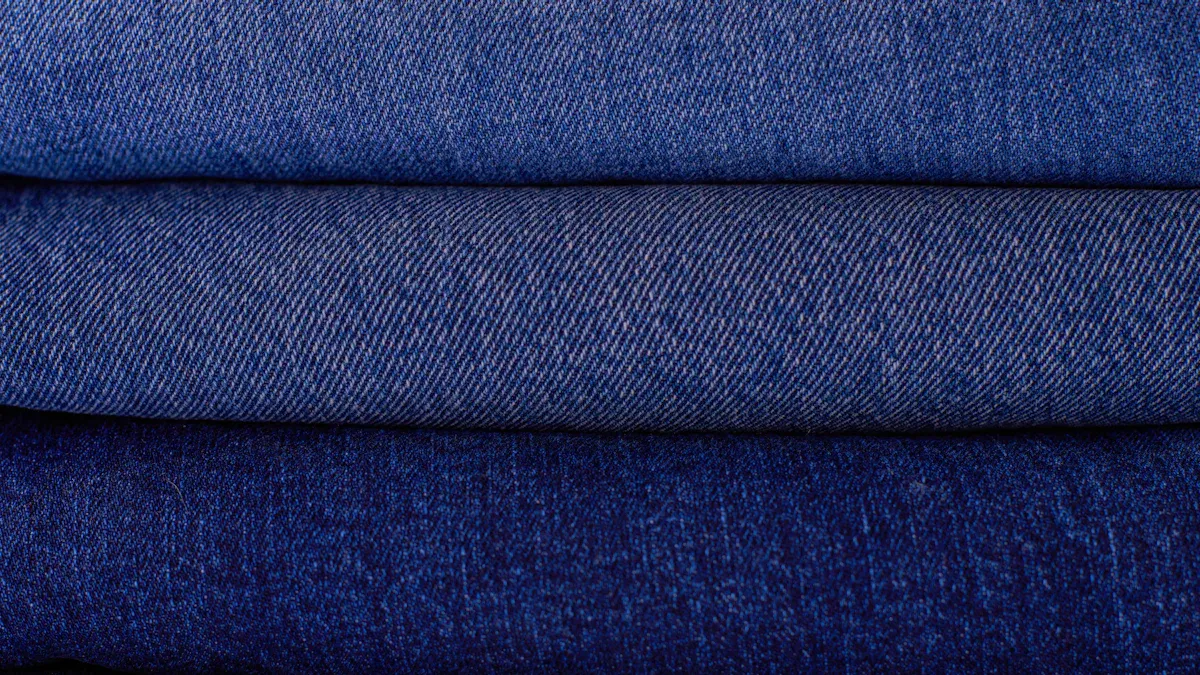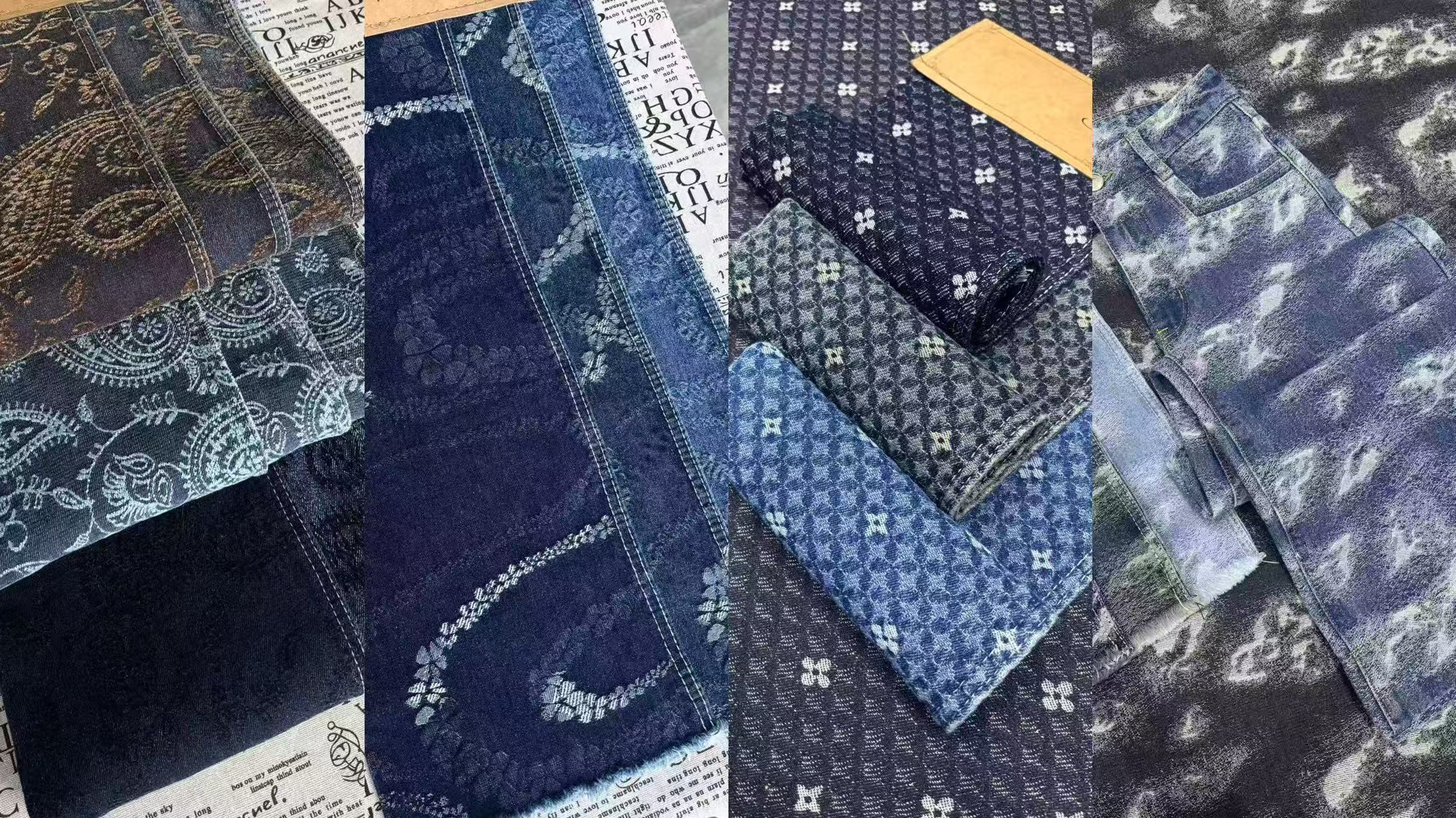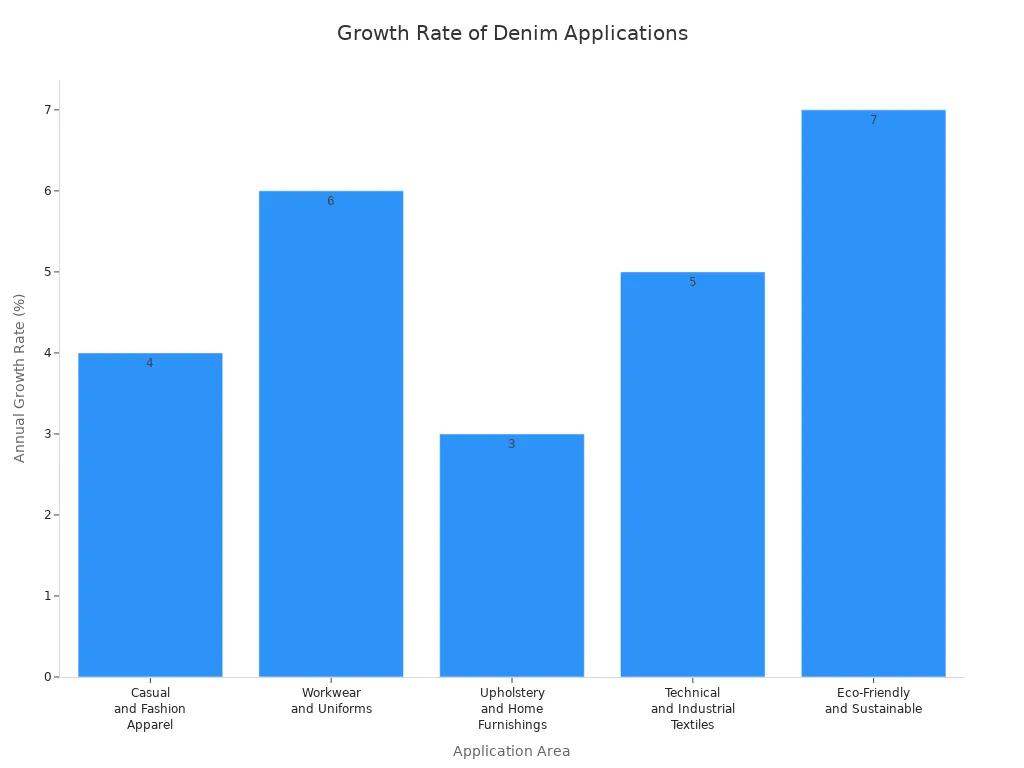
You might wonder what is denim made of in 2025. Denim now uses cotton, synthetics, and blends. This change matters for comfort, health, and sustainability. Many people still prefer cotton, but more brands offer jeans with polyester or recycled fibers because of better stretch and lighter weight.
Denim makers focus on performance and sustainability.
Mills show that high performance and low impact can work together.
Region | Consumer Priorities | Demographic Focus |
|---|---|---|
Japan | Premium quality, sustainability | High-end consumers, aging population |
South Korea | Innovation, trendsetting, sustainability | Young consumers, streetwear fans |
General | Sustainability, fashion trends | All groups |
Think about what matters most to you: comfort, durability, sustainability, or price.
Key Takeaways
Denim in 2025 combines cotton, synthetics, and blends for comfort and performance.
Cotton denim offers softness and breathability, while synthetic options provide stretch and quick drying.
Recycled and eco-friendly materials reduce environmental impact and support sustainability.
Blended denim combines the best features of cotton and synthetics for durability and comfort.
When shopping for jeans, consider comfort, durability, sustainability, and price to find the best fit for your needs.
What is denim made of in 2025
You see denim everywhere, but what is denim made of today? In 2025, denim uses a mix of cotton, synthetics, and blended fibers. Brands now combine these materials to create jeans that fit your needs for comfort, durability, and sustainability. You notice more recycled fibers and advanced production methods in stores. This shift changes how denim feels and performs.
Cotton denim
Cotton denim remains popular because it feels soft and breathes well. You get natural comfort and a classic look. Cotton absorbs moisture and keeps you cool. Many people choose cotton denim for everyday wear. You find that cotton denim wrinkles easily and dries slowly, but it offers eco-friendly benefits when brands use recycled cotton. Major brands now launch collections with recycled denim blends. These blends help reduce water usage by up to 90%, making denim production more efficient. H&M partners with Recover™ to improve access to high-quality recycled fibers. The mechanical recycling process uses less energy and water than traditional cotton production. You support sustainability when you buy jeans made with recycled cotton.
Tip: If you want jeans that feel soft and help the planet, look for labels that mention recycled cotton or waterless dyeing.
Here is a quick comparison of physical properties:
Attribute | 100% Cotton | Cotton-Poly (70/30) | Cotton-Tencel (80/20) | Cotton-Elastane (95/5) |
|---|---|---|---|---|
Breathability | ⭐⭐⭐⭐⭐ | ⭐⭐ | ⭐⭐⭐⭐ | ⭐⭐⭐⭐ |
Abrasion Resistance | ⭐⭐ | ⭐⭐⭐⭐⭐ | ⭐⭐⭐ | ⭐⭐ |
Wrinkle Recovery | ⭐⭐ | ⭐⭐⭐⭐ | ⭐⭐⭐ | ⭐⭐⭐ |
Stretch Recovery | ⭐⭐ | ⭐⭐ | ⭐⭐⭐ | ⭐⭐⭐⭐⭐ |
Drying Speed | ⭐⭐ | ⭐⭐⭐⭐⭐ | ⭐⭐⭐ | ⭐⭐ |
Eco-Friendliness | ⭐⭐⭐⭐ | ⭐⭐ | ⭐⭐⭐⭐ | ⭐⭐⭐ |
Synthetic denim
Synthetic denim uses fibers like polyester, nylon, or elastane. You notice these jeans stretch more and resist wrinkles. Synthetic fibers dry quickly and last longer under tough conditions. You find synthetic denim in activewear and fashion-forward styles. These jeans often cost less and offer high abrasion resistance. Synthetic denim production uses less water than cotton, especially when brands use lyocell. Lyocell production reduces water usage by 30-40%, using about 600-800 liters per kilogram. The closed-loop system in lyocell manufacturing lowers toxic discharge and energy needs. You get jeans that perform well and dry fast.
Note: Synthetic denim feels different from cotton. If you want jeans for sports or travel, synthetic blends may suit you best.
Blended denim
Blended denim combines cotton with synthetics like polyester, lyocell, or elastane. You get the best of both worlds. These jeans stretch, recover shape, and resist wrinkles. Blended denim offers improved durability and comfort. You see brands mixing cotton with elastane for skinny jeans or with lyocell for eco-friendly options. Production lines now use renewable energy and advanced automation. High-efficiency looms and smart finishing units lower emissions and keep quality high. You benefit from jeans that last longer and support sustainable practices.
Cotton blends use less water and energy than pure cotton.
Lyocell blends minimize toxic discharge.
Recycled cotton in blends boosts eco-friendliness.
When you ask what is denim made of, you find that the answer depends on your priorities. Cotton, synthetics, and blends each offer unique benefits. You choose jeans based on comfort, style, and how much you care about the environment. Denim in 2025 gives you more options than ever before.
Cotton vs synthetic denim

Feel and comfort
When you choose denim, you notice how it feels against your skin. Cotton denim gives you a soft, breathable experience. You enjoy wearing it for long hours because it absorbs moisture and keeps you cool. Many people prefer cotton because it feels natural and gentle. Synthetic denim, made with fibers like polyester or elastane, offers more stretch and flexibility. You find these jeans fit snugly and move with your body. However, synthetic denim can feel less breathable and sometimes trap heat. Some blends, such as cotton-elastane, combine comfort with stretch, giving you jeans that feel good and fit well.
Tip: If you have sensitive skin, you may want to check the label for cotton content. Synthetic denim can contain chemicals from manufacturing that may cause irritation.
You might wonder what is denim made of when you shop for jeans. The answer affects how comfortable your jeans feel throughout the day.
Common health concerns with synthetic denim in 2025:
Chemicals used in manufacturing can remain on the fabric and lead to skin reactions.
Formaldehyde resin treatments, which improve durability, may cause irritation.
Dyes in synthetic fabrics, especially disperse dyes, can penetrate the skin and trigger itching or eczema.
Durability
You want your jeans to last, especially if you wear them often. Cotton denim has moderate natural strength and breathability. You find it comfortable, but it may tear or fray with heavy use. Synthetic denim and blends, such as cotton-polyester, offer higher abrasion resistance and dry faster. These jeans resist shrinking and keep their shape after many washes. Cotton-elastane blends give you flexibility and freedom of movement, but they may not feel like traditional denim.
Here is a table comparing durability attributes in 2025:
Denim Type | Durability Attributes | Advantages | Limitations |
|---|---|---|---|
High-Cotton Denim | Moderate natural strength | Excellent breathability, skin-friendly | Lower abrasion resistance, prone to tearing |
Cotton-Polyester Blend | Enhanced abrasion resistance | Faster drying, minimized shrinkage | Reduced breathability, synthetic feel |
Cotton-Lyocell Blend | Improved moisture management | Silky drape, better biodegradability | Lower wet strength, higher cost |
Cotton-Elastane Blend | Increased flexibility | Better freedom of movement | May lack traditional denim feel |
You see denim patchwork resist fraying and stains, even after exposure to sweat and rain. Synthetic denim may dull in color more quickly after contact with water and sweat. Overall, cotton denim proves more durable for active lifestyles, while blends offer extra strength for everyday use.
Sustainability
You care about the environment when you buy new clothes. Cotton denim, especially when made with recycled fibers, supports eco-friendly practices. Brands use less water and energy to produce recycled cotton denim. You help reduce waste and pollution by choosing these options. Synthetic denim uses less water during production, especially with fibers like lyocell. Lyocell blends minimize toxic discharge and use renewable energy. However, synthetic denim can contain chemicals that harm the environment if not managed properly.
Note: If you want to support sustainability, look for jeans made with recycled cotton or lyocell blends. These options help lower your environmental impact.
You may ask what is denim made of when you want to make a responsible choice. The answer guides you toward jeans that match your values.
Price
You notice price differences when you compare cotton and synthetic denim. Cotton denim often costs more because of natural fiber sourcing and eco-friendly production. Synthetic denim and blends usually cost less, making them popular for budget shoppers. Cotton-lyocell blends may have higher prices due to advanced manufacturing and better biodegradability. You balance cost with comfort, durability, and sustainability when you choose your jeans.
Cotton denim: Higher price, classic feel, eco-friendly options.
Synthetic denim: Lower price, more stretch, quick-drying.
Blended denim: Mid-range price, combines benefits of both.
You decide what matters most—comfort, durability, sustainability, or price—when you shop for denim in 2025.
Choosing your denim
Everyday wear
You want jeans that fit your daily routine. Denim for everyday wear should feel comfortable and last through many washes. When you shop, check these factors:
Fit and comfort help you move easily.
Fabric quality gives you durability and stretch.
Design and style match your wardrobe.
Sustainability shows the brand cares about the planet.
Price and value balance cost with how long the jeans last.
Wash and finish let you pick your favorite look.
Brand reputation means you get trusted quality.
Fabric stretch lets your jeans move with you.
Rise and fit create a flattering shape.
Thoughtful details, like reinforced seams and deep pockets, add convenience.
Tip: Try on different styles to find jeans that feel good and look great. You can choose classic straight-leg or modern skinny fits.
Fashion trends
You see denim styles change every year. In 2025, fashion trends focus on comfort, sustainability, and unique designs. Many brands use new blends and recycled fibers to create fresh looks. You notice these trends:
Sustainable and ethically produced denim gains popularity.
Millennials and Gen Z prefer brands that show transparency and social responsibility.
Customizable and innovative denim lets you express your style.
Comfort and durability guide your choices.
You can pick jeans with bold washes, patchwork, or creative cuts. Many brands offer limited-edition collections that use eco-friendly materials. You make a statement with your denim while supporting responsible fashion.
Eco-friendly options
You care about the environment when you buy jeans. Eco-friendly denim uses recycled cotton, lyocell, or blends that save water and energy. Brands now share details about their materials and production methods. You can look for:
Eco-Friendly Feature | What It Means for You |
|---|---|
Recycled fibers | Less waste, lower water use |
Waterless dyeing | Reduced pollution |
Ethical manufacturing | Fair wages, safe workplaces |
Renewable energy | Lower carbon footprint |
Note: Check labels for certifications like GOTS or OEKO-TEX. These show the jeans meet high environmental standards.
You choose denim that matches your values and supports a cleaner future.
The future of denim fabrics

Material innovations
You see denim evolving quickly as brands introduce new materials and technologies. Sustainability drives many of these changes. You find organic cotton, plant-based dyes, and recycled fibers in more jeans than ever before. Advanced washing techniques create soft-touch finishes while keeping denim durable. Trompe-l’œil denim imitates leather or other textures, giving you a modern look without sacrificing comfort.
TENCEL Lyocell – HV100 stands out as a new fiber. You get authentic denim style with a soft feel and textured surface. This fiber keeps the classic matte look and wash-down performance you expect from denim.
Denim makers use innovative blends to improve stretch, breathability, and eco-friendliness.
You notice brands focusing on wrinkle resistance and water repellency, making jeans easier to care for.
Tip: If you want jeans that combine style and sustainability, look for labels mentioning TENCEL Lyocell or recycled materials.
You see denim used in more places, from casual wear to technical textiles. The table below shows how new materials benefit different applications:
Application | Key Benefits | Growth Rate |
|---|---|---|
Casual and Fashion Apparel | Comfort, style versatility, sustainable options (organic/recycled blends) | 4% annual growth |
Workwear and Uniforms | Durability, abrasion resistance, employee comfort | 6% annual increase |
Upholstery and Home Furnishings | Durability, ease of cleaning, casual aesthetic | 3% annual growth |
Technical and Industrial Textiles | Strength, breathability, eco-conscious products (reusable bags) | 5% growth by 2025 |
Eco-Friendly and Sustainable | Biodegradable products, organic cotton, sustainable dyeing processes | 7% annual increase |

Sustainability trends
You notice denim brands working hard to protect the environment. Recycled denim is becoming more common as companies respond to regulations and consumer demand. You see new dyeing methods that use less water and energy. Levi Strauss & Co. aims to cut freshwater use by 15% by 2030, and other brands follow similar goals.
Archroma’s Denim Halo offers a sustainable alternative to traditional finishing, reducing water and energy use.
Brands like Target and Universal Thread use recycled cotton in their collections and run take-back events to recycle old jeans.
Stella McCartney showcases upcycled denim waistbands, showing commitment to long-term sustainability.
Denim makers eliminate harmful chemicals, such as potassium permanganate, from their products.
Initiative | Description |
|---|---|
Water Usage Reduction | Target reduced water usage by 64% in FY2024. |
CO2 Emissions Reduction | Target achieved a 70% reduction in CO2 emissions. |
Chemical Elimination | Potassium permanganate was eliminated from all owned brand denim products. |
Recycled Materials | 20% of Universal Thread’s denim items are made with recycled cotton. |
Circular Economy | Target collected over 65,000 lbs. of denim for recycling through a take-back event. |
You see more brands adopting waterless dyeing and regenerative agriculture. Supply chains become more transparent, helping you make informed choices. Denim’s future looks bright as companies focus on eco-friendly materials, circular initiatives, and innovative designs.
Note: If you want to support sustainability, choose denim made with recycled fibers and look for brands that share their environmental progress.
You see denim in 2025 made from cotton, synthetics, and blends. Premium brands use more organic and recycled fibers. Hybrid blends give you comfort and durability. Cotton feels soft and natural, while synthetics add stretch and quick drying. Health and sustainability matter. Many people prefer eco-friendly denim.
Soft knitted denim and cotton-spandex blends improve comfort.
Recycled materials help reduce waste.
Organic denim supports transparency and sustainability.
Consumer Preference | Percentage |
|---|---|
Prefer eco/sustainable products | 68% |
Willing to pay 10-15% more for eco fabrics | 55% |
Choose denim that matches your comfort, durability, and values.
FAQ
What is the main material in denim jeans today?
You find most denim jeans use cotton. Many brands add synthetic fibers like polyester or elastane for stretch and durability. Blended denim gives you comfort and performance.
Are synthetic denim fabrics safe for sensitive skin?
You may experience irritation from chemicals in synthetic denim. If you have sensitive skin, choose jeans with high cotton content or look for OEKO-TEX certified labels.
How do I know if my jeans are eco-friendly?
Check the label for recycled cotton, lyocell, or organic fibers. Look for certifications like GOTS or OEKO-TEX. Brands often share sustainability details on their websites.
Do blended denim jeans last longer than pure cotton jeans?
Blended denim often lasts longer. Synthetic fibers increase abrasion resistance and stretch. You get jeans that keep their shape and resist wear.
Can you recycle old denim jeans?
Yes! Many brands and stores offer take-back programs. You can donate old jeans for recycling. Recycled denim helps reduce waste and supports sustainability.
